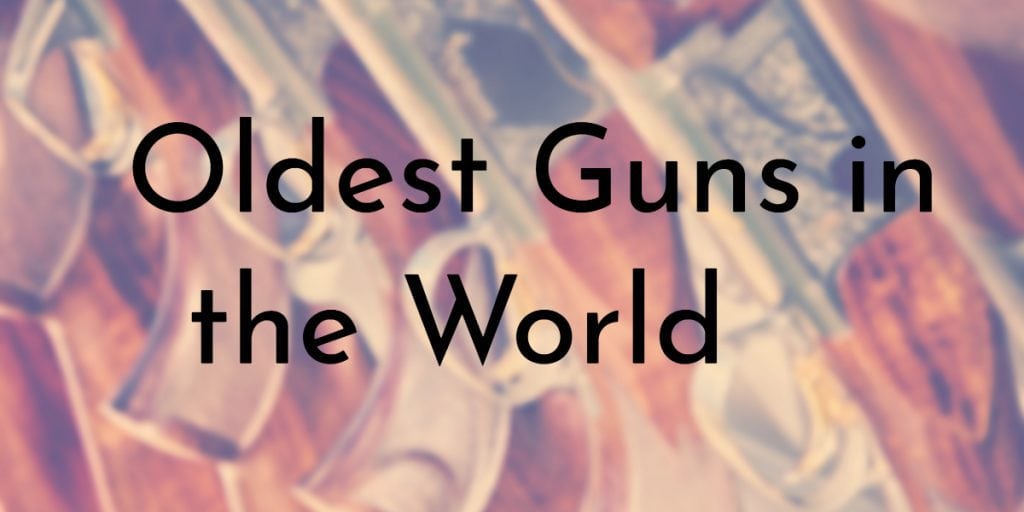The first firearms were created in China after the Chinese invented black powder in the 9th century. The earliest depiction of a gun dates back to the 12th century and the oldest existing firearm is from around 1288. Before firing mechanisms were created, early firearms needed to be manually ignited by holding a burning wick to a touch hole.
Once the first firearms were introduced, gun technology advanced quite rapidly as various empires waged war. Since guns are widely collected, their history and early examples have been well-documented. This list contains some of the oldest and best examples of various early guns.
9. Gatling Gun
Year Created: 1862
Country of Origin: United States of America
Gunsmith: Dr. Richard J. Gatling
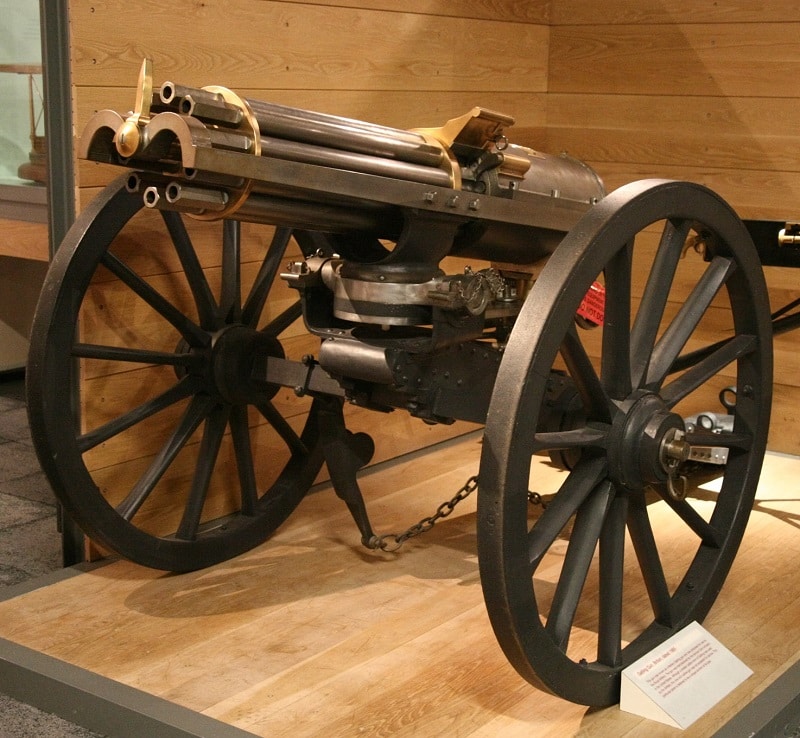
The Gatling gun is the best example of early rapid fire weapons — it is the forerunner of the modern machine gun. The gun was designed in 1861 by Richard Gatling and patented the following year. The Gatling gun was first used in war during the American Civil War. Twelve guns were purchased by Untion commanders and used during the siege of Petersburg, Virginia.
After the American Civil War, the Gatling gun was used in international conflicts such as the Boshin War and the Anglo-Zulu War. It was also used by American forces during the Spanish-American War at the Battle of San Juan Hill. Today, there are several automatic rotary machine guns that were influenced by the design of the Gatling gun.
8. Colt Revolver
Year Created: 1836
Country of Origin: United States of America
Gunsmith: Samuel Colt
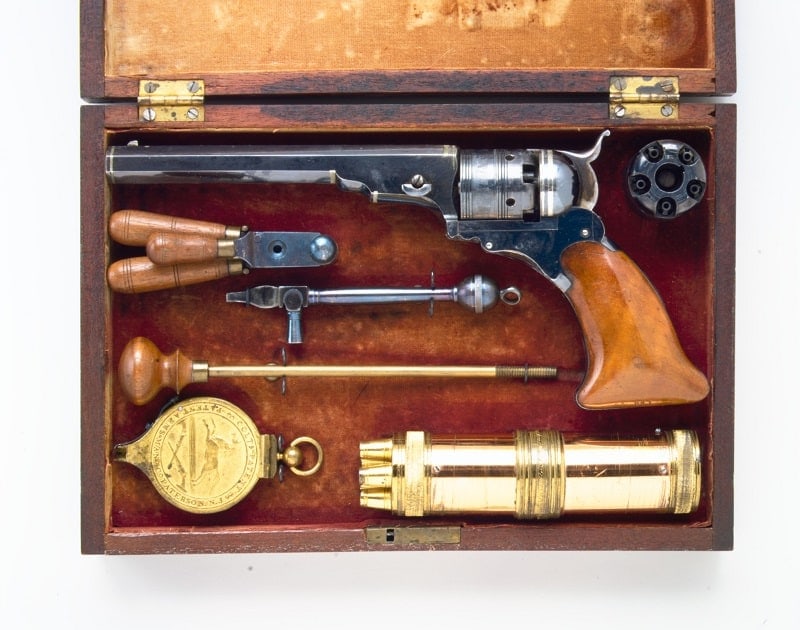
Although manually revolving guns had existed for a centuries, Samuel Colt‘s guns were the first truly successful revolvers. Colt received the first patent for his revolving mechanism in Britain in 1835 and a year later, he obtained the U.S. patent. In 1836, Colt founded the Patent Arms Manufacturing Company in Paterson, New Jersey. Colt continued to manufacture guns at this company until 1842 after a string of patchy success.
Initially, Colt was unable to secure a government contract for his guns. However, Colt was finally granted a contract in 1846 when the Mexican-American War was underway. Colt worked with Captain Samuel H. Walker to improve his revolver and General Zachary Taylor ordered 1,000 Colt revolvers.
Colt’s guns continued to grow in popularity and today, the Colt Manufacturing Company is one of the most widely recognized gun manufacturers in the world.
7. Musket Modèle 1777
Year Created: 1777
Country of Origin: France
Gunsmith: Charleville armoury and others
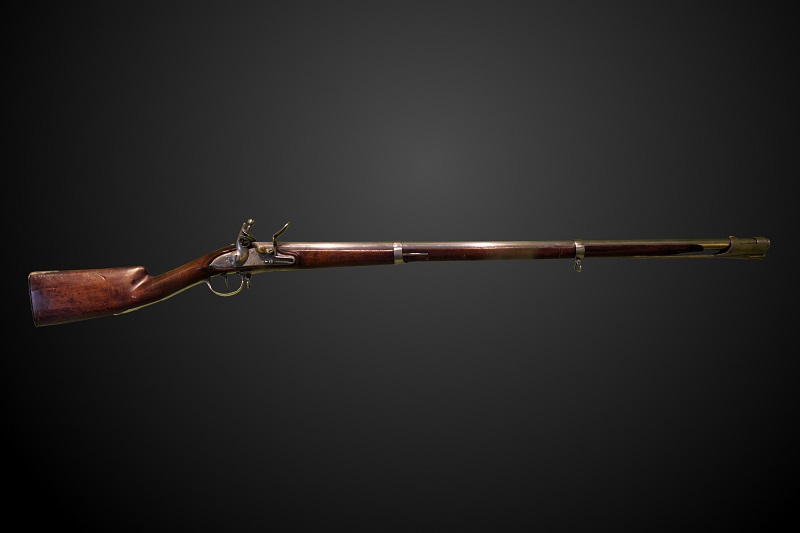
The musket Modèle 1777 was one of the most widely used weapons in continental Europe. It was initially created in 1777 for the French Army. Trained French infantrymen were expected to be able to fire three volleys a minute with this musket. Between 1777 — 1826, about 7 million Modèle 1777 muskets were produced — this number was not topped until World War I.
In the early 1800s, after the French Revolutionary Wars, Napoleon Bonaparte wanted the muskets to be slightly reworked. The corrected model, “Modèle 1777 corrigé, featured some minor modifications on the lock, bayonet, and stock. Other small improvements of the musket occurred in 1816 and 1822.
6. Puckle Gun
Year Created: 1718
Country of Origin: United Kingdom
Gunsmith: James Puckle
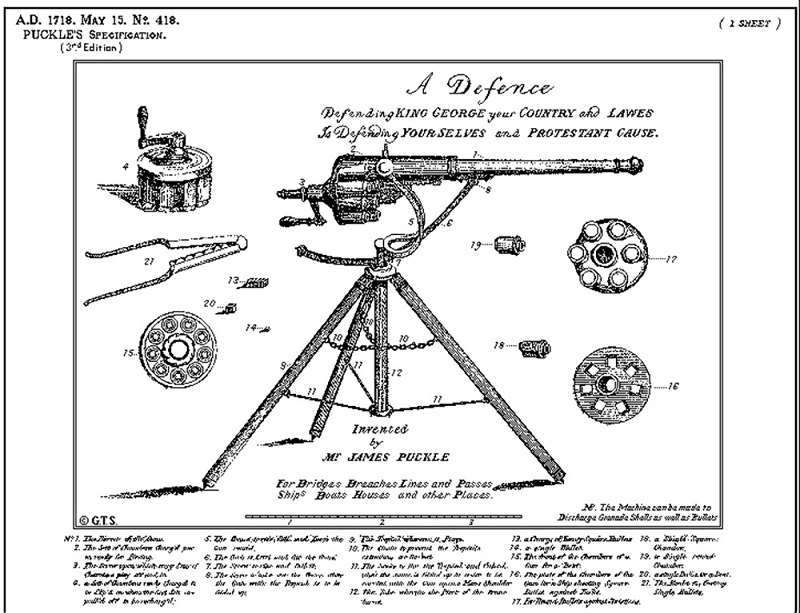
The Puckle Gun was one of the first weapons to be called a “machine gun”, but its mechanisms do not resemble modern machine guns. The gun was patented by James Puckle in 1718. It was a tripod-mounted, single-barrel flintlock weapon with a manually operated revolving cylinder. Puckle thought that it could be used on ships as an anti-boarding gun.
The Puckle gun never picked up many investors and Puckle was unable to sell the guns to the British armed forces.
Two original examples of the Puckle gun are on display at the Boughton House and Beaulieu Palace. These guns were purchased by John Montagu, 2nd Duke of Montagu, Master-General of the Ordnance in 1722.
5. King Louis XIII’s Flintlock Gun
Year Created: c.1620
Country of Origin: Lisieux, France
Gunsmith: Pierre Le Bourgeois and Marin Le Bourgeois
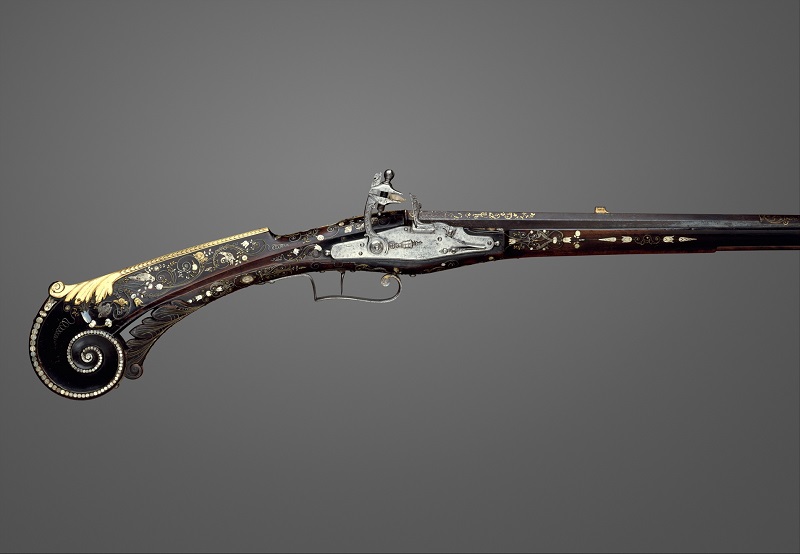
One of the greatest advancements in gun technology was the invention of the flintlock mechanism. The first true flintlocks were created in France in the early 17th century. Flintlocks were commonly used over the next two centuries until the invention of the percussion lock.
An early example of a French flintlock gun (pictured above), is the one owned by King Louis XIII. It was created in the workshop directed by Pierre Le Bourgeois’ brother, Marin. He is typically attributed as the inventor of the flintlock mechanism. The gun is decorated with Louis XIII’s crowned monogram and the scroll-shaped end of the gun is a unique design.
Today, King Louis XIII’s flintlock gun is on display at The Met Fifth Avenue in Gallery 375.
4. Georg von Reichwein’s Revolver
Year Created: 1597
Country of Origin: Nuremburg, Germany
Gunsmith: Hans Stopler
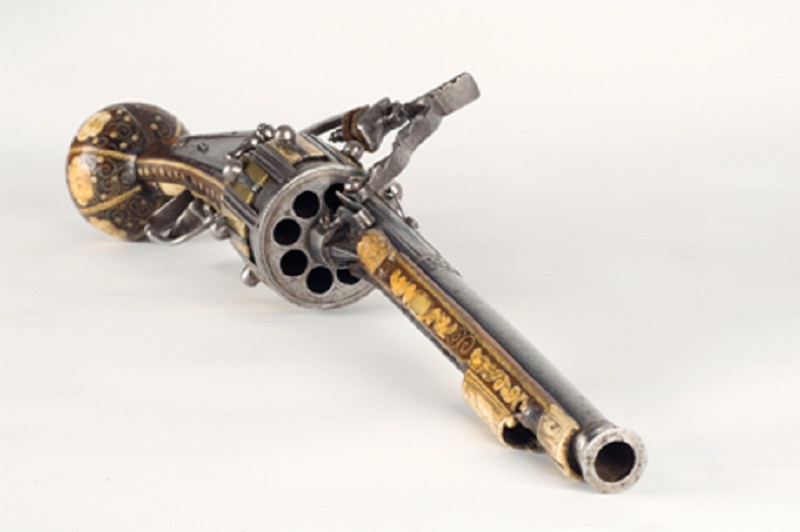
The gun owned by Georg von Reichwein, a German officer during the mid-17th century, is the oldest existing revolver in the world. Stamp marks on the gun provide definitive evidence that the revolver was created by Hans Stopler, a German weapons blacksmith, in 1597. The gun was made for someone of high status and is decorated with brass, bone, and Mother of Pearl.
Unlike modern revolvers, this gun had to be manually rotated.
Georg von Reichwein was the last owner of the gun, and bought it when he was appointed to major and commander of the forces at Bergenhus fortress of Norway in 1636. The revolver currently resides in the storage rooms of the Maihaugen Folk Museum in Lillehammer, Norway. It was briefly put on display in 2014 for the 200th anniversary of the Norwegian Constitution.
3. Tanegashima
Year Created: c.1543
Country of Origin: Japan
Gunsmith: Yaita – first commissioned by Lord Tanegashima Tokitaka
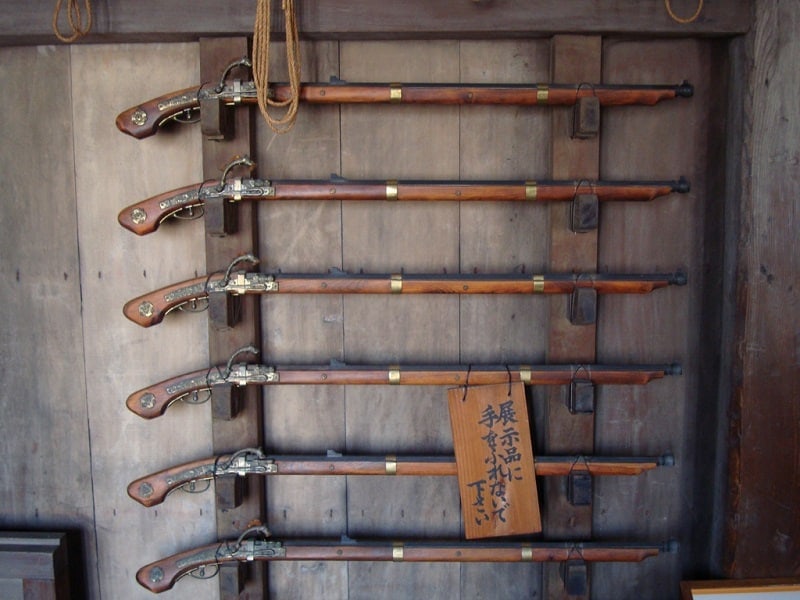
Tanegashima were matchlock guns from Japan that were used by the samurai and their foot soldiers. Matchlock guns were first introduced to Japan by the Portuguese in 1543.
Portuguese adventurers were forced to land on Tanegashima island during a storm. The lord of the island, Tanegashima Tokitaka, purchased two matchlock muskets from the Portuguese and asked a swordsmith to copy the guns’ mechanisms. However, the smith ran into problems, which were not solved until the following year when a Portuguese gunsmith was brought to Japan.
Over the next decade, over 300,000 Tanegashima guns were produced, which changed the nature of Japanese warfare.
2. Emperor Charles V’s Wheellock Pistol
Year Created: c. 1540 – 1545
Country of Origin: Munich, Germany
Gunsmith: Peter Peck
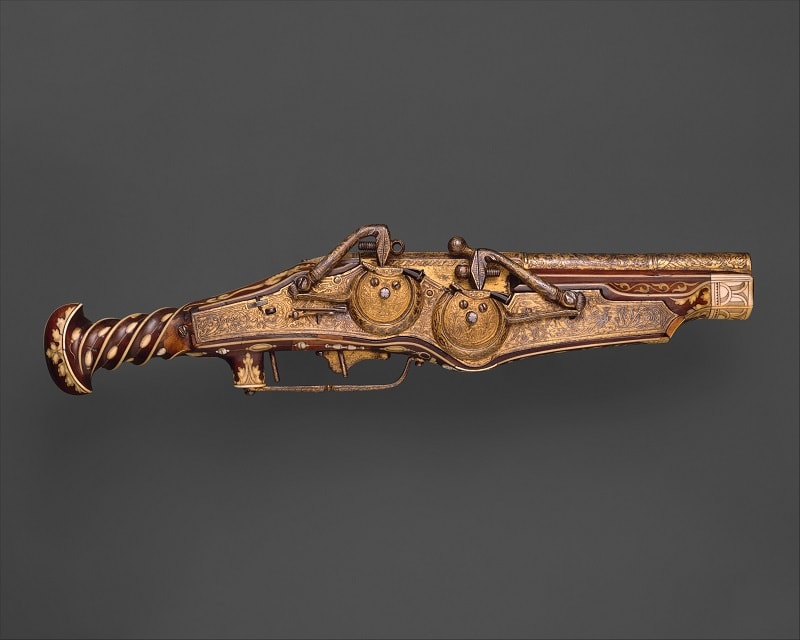
As gun technology progressed, different firing mechanisms were created. Although matchlock guns are older than wheellocks, very few examples survive. However, many wheellocks, which were first created in the early 1500s still exist. Wheellock guns were the first self-igniting firearms, which meant that they could be fired efficiently with one hand.
The double-barreled wheellock pistol made for King Charles V (pictured above) is one of the earliest surviving pistols, dating back to around 1540 – 1545. It was created by Peter Peck of Germany, who also made fine watches. This gun features two locks combined into one firing mechanism, which meant that each barrel could be ignited separately.
It is decorated with Charles V’s personal emblems: the double-headed eagle and the pillars of Hercules with the Latin motto PLVS VLTRA (which means “More Beyond”).
1. Heilongjiang Hand Cannon
Year Created: c.1288
Country of Origin: Banlachengzi, Heilongjian province, China
Gunsmith: Unknown
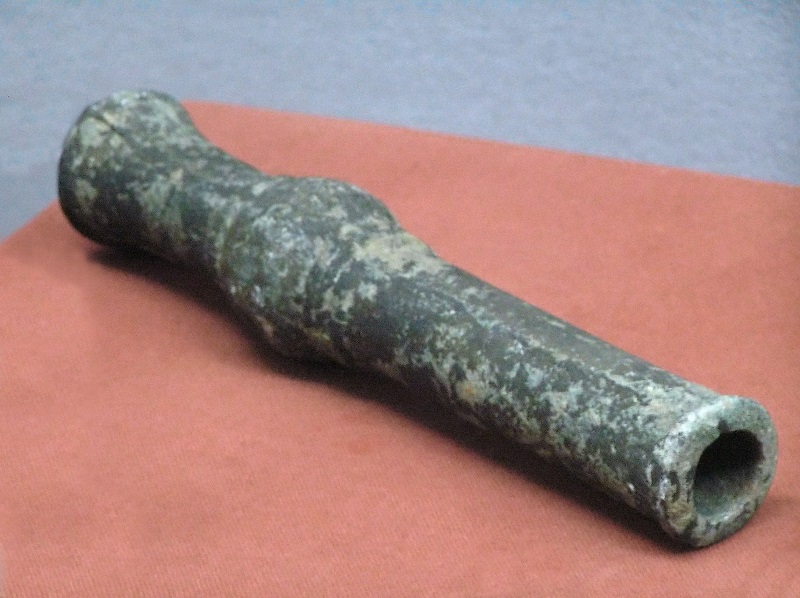
The Heilongjiang hand cannon is believed to be the oldest existing gun in the world. While the hand cannon is not exactly a gun, it was one of the first firearms ever created and is the precursor to modern guns. This particular hand cannon was found during a 1970 excavation at the village of Banlachengzi, China.
Researchers think that the hand cannon was used in battles sometime between 1287 – 1288. In an account from the time period called History of Yuan, a commander named Li Ting led a group of soldiers who were equipped with hand cannons, as part of an anti-rebellion campaign for the Yuan dynasty.
Today, the hand cannon is on display at the Heilongjiang Provincial Museum in Harbin, China.
OTHER POSTS YOU MAY BE INTERESTED IN


